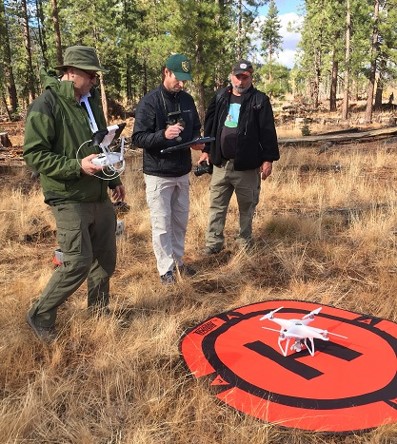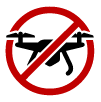Wildlife Disturbance
Many animals perceive a drone as a predator or other threat and will react accordingly. The reaction could be obvious like attacking or fleeing, or it may be a subtle reaction that isn’t obvious to the casual observer. Both reactions can be detrimental to wildlife.
Nesting birds are particularly vulnerable to disturbance caused by drones. If a nesting bird is scared off its nest by a drone, the eggs and chicks in the nest become vulnerable to predators; if the adult permanently abandons the nest, all of the eggs and chicks will die. Even if a nesting bird doesn’t immediately flee, the cumulative effect of multiple disturbances can cause the bird to abandon the nest.
As an example, on May 12, 2021 an illegally operated drone(opens in new tab) crashed at the CDFW Bolsa Chica Ecological Reserve, resulting in approximately 3,000 Elegant Terns leaving their nesting grounds and abandoning an estimated 2,000 eggs.
Avoiding Wildlife Disturbance

Below are some basic best-practices that will help you avoid disturbing wildlife when you operate your drone:
- Be alert for wildlife, especially birds, before you fly.
- Launch and land at least 300 ft. from any wildlife in the area.
- Never fly lower than 100 ft. over wildlife.
- Do not pursue or otherwise provoke a response from wildlife with your drone. If you notice a response, back off.
- When possible, have a wildlife observer with you to help you spot and avoid wildlife.
Key California Regulations that apply to the use of drones
California Code of Regulations, Title 14, Section 550 (aa) – General Regulations for Public Use on All Department of Fish and Wildlife Lands
Aircraft. No visitor shall
operate any aircraft, drone, or other unmanned aircraft system (UAS),
hovercraft, or hot air balloon within department lands except as authorized by
a Special Use Permit issued by the department.
 Plain language summary: You may not operate a drone on Department Lands without a Special Use Permit (PDF)(opens in new tab). Additionally, it is unlikely that the California Department of Fish and Wildlife will approve a permit request for a drone operation that isn't in line with the compatible uses of the property, such as scientific research or land/wildlife management activities.
Plain language summary: You may not operate a drone on Department Lands without a Special Use Permit (PDF)(opens in new tab). Additionally, it is unlikely that the California Department of Fish and Wildlife will approve a permit request for a drone operation that isn't in line with the compatible uses of the property, such as scientific research or land/wildlife management activities.
Resources
California Fish and Game Code 10501.5 – Refuges and Other Protected Areas(opens in new tab)
(a) It is unlawful to fly any aircraft, including any airplane or helicopter, less than 3,000 feet above water or land over the Sespe Condor Sanctuary, and less than 1,000 feet above water or land over the Año Nuevo State Reserve, the Farallon Islands Game Refuge, the Point Lobos State Reserve, the California Sea Otter Game Refuge, and Anacapa, San Miguel, Santa Barbara, and San Nicolas Islands, except for rescue operations, in case of any emergency, or for scientific or filmmaking purposes under a permit issued by the department after a review of potential biological impacts.
(b) This section does not apply to the landing of any aircraft, including any airplane or helicopter, on Anacapa, San Miguel, Santa Barbara, San Nicolas, and Farallon Islands for administrative or operational purposes of the National Park Service, the United States Navy, or the United States Coast Guard.
Plain language summary: You may not operate a drone on or over these protected properties without a Letter of Authorization from the area manager.
California Code of Regulations, Title 14, Section 251 - Prohibition on Pursuing or Shooting Birds and Mammals from Motor-Driven Air or Land Vehicles, Motorboats, Airboats, Sailboats or Snowmobiles(opens in new tab)
(a) General Prohibition: No person shall pursue, drive, herd, or take any bird or mammal from any type of motor-driven air or land vehicles, motorboat, airboat, sailboat, or snowmobile. Additionally, no person shall use any motorized, hot-air, or unpowered aircraft or other device capable of flight or any earth orbiting imaging device to locate or assist in locating big game mammals beginning 48 hours before and continuing until 48 hours after any big game hunting season in the same area. No person shall use at any time or place, without Department approval, any computer, telemetry device or other equipment to locate a big game mammal to which a tracking device is attached. For purposes of this subsection "use" includes but is not limited to personal use or intent by another to obtain information from such personal use. Evidence of an act constituting a violation of this section includes but is not limited to flying slowly at low attitudes, hovering, circling or repeatedly flying over any area where big game may be found.
California Code of Regulations, Title 14, Section 251.1 - Harassment of Animals(opens in new tab)
Except as otherwise authorized in these regulations or in the Fish and Game Code, no person shall harass, herd, or drive any game or nongame bird or mammal or furbearing mammal. For the purposes of this section, harass is defined as an intentional act which disrupts an animal's normal behavior patterns, which includes, but is not limited to, breeding, feeding, or sheltering. This section does not apply to a landowner or tenant who drives or herds birds or mammals for the purpose of preventing damage to private or public property, including aquaculture and agriculture crops.
California Fish and Game Code 3503 – Take of bird nests(opens in new tab)
It is unlawful to take, possess, or needlessly destroy the nest or eggs of any bird, except as otherwise provided by this code or any regulation made pursuant thereto.
If you have wildlife drone questions or concerns, please contact the CDFW Drone Program at UASCoordinator@wildlife.ca.gov.